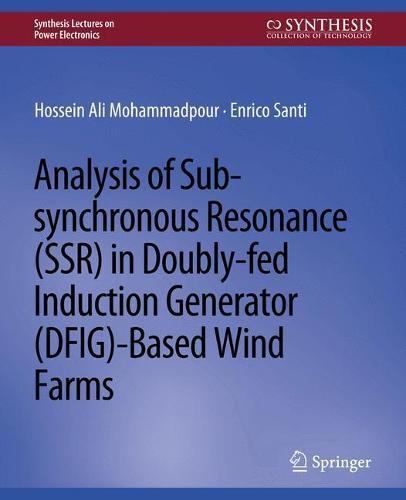Overview
Wind power penetration is rapidly increasing in today's energy generation industry. In particular, the doubly-fed induction generator (DFIG) has become a very popular option in wind farms, due to its cost advantage compared with fully rated converter-based systems. Wind farms are frequently located in remote areas, far from the bulk of electric power users, and require long transmission lines to connect to the grid. Series capacitive compensation of DFIG-based wind farm is an economical way to increase the power transfer capability of the transmission line connecting the wind farm to the grid. For example, a study performed by ABB reveals that increasing the power transfer capability of an existing transmission line from 1300 MW to 2000 MW using series compensation is 90% less expensive than building a new transmission line. However, a factor hindering the extensive use of series capacitive compensation is the potential risk of subsynchronous resonance (SSR). The SSR is a condition where the wind farm exchanges energy with the electric network, to which it is connected, at one or more natural frequencies of the electric or mechanical part of the combined system, comprising the wind farm and the network, and the frequency of the exchanged energy is below the fundamental frequency of the system. This oscillatory phenomenon may cause severe damage in the wind farm, if not prevented. Therefore, this book studies the SSR phenomenon in a capacitive series compensated wind farm. A DFIG-based wind farm, which is connected to a series compensated transmission line, is considered as a case study. The book consists of two main parts: Small-signal modeling of DFIG for SSR analysis: This part presents a step-by-step tutorial on modal analysis of a DFIG-based series compensated wind farm using Matlab/Simulink. The model of the system includes wind turbine aerodynamics, a 6th order induction generator, a 2nd order two-mass shaft system, a 4th order series compensated transmissionline, a 4th order rotor-side converter (RSC) controller and a 4th order grid-side converter (GSC) controller, and a 1st order DC-link model. The relevant modes are identified using participation factor analysis. Definition of the SSR in DFIG-based wind farms: This part mainly focuses on the identification and definition of the main types of SSR that occur in DFIG wind farms, namely: (1) induction generator effect (SSIGE), (2) torsional interactions (SSTI), and (3) control interactions (SSCI).
Full Product Details
Author: Hossein Ali Mohammadpour ,
Enrico Santi
Publisher: Springer International Publishing AG
Imprint: Springer International Publishing AG
Weight: 0.152kg
ISBN: 9783031013737
ISBN 10: 3031013735
Pages: 55
Publication Date: 01 September 2015
Audience:
Professional and scholarly
,
Professional & Vocational
Format: Paperback
Publisher's Status: Active
Availability: Manufactured on demand

We will order this item for you from a manufactured on demand supplier.
Language: English
Author Information
Hossein Ali Mohammadpour (IEEE S '2009 - M '2015) received the B.Sc. and M.Sc. degrees all in electrical engineering power systems from the Iran University of Science and Technology (IUST), Tehran, Iran, in 2006 and 2009, respectively. He also received the Ph.D. degree in electrical engineering with focus on renewable energy systems from the University of South Carolina, Columbia, SC, USA, in December 2014, where he continued as a postdoctoral fellow until March 2015. Since March 2015, he has been with the NRG Renew, Scottsdale AZ, USA as a Senior Power Systems Engineer. Dr. Mohammadpour has published over fifty papers in power systems, power electronics, and renewable energy resources in international journals and conference proceedings. His current research interests include power systems stability and control, micro-grid systems, photovoltaic, battery energy storage systems, and smart grid. Enrico Santi received the Dr. Ing. degree in electrical engineering from the University of Padua, Italy in 1988 and the M.S. and Ph.D. degrees from Caltech in 1989 and 1994, respectively. He worked as a senior design engineer at TESLAco from 1993 to 1998, where he was responsible for the development of various switching power supplies for commercial applications. Since 1998 he has been with the University of South Carolina where he is currently an associate professor in the electrical engineering department. Dr. Santi has published over one hundred and fifty papers in power electronics and modeling and simulation in international journals and conference proceedings, is co-author of two books and holds three patents. His research interests include switched-mode power converters, advanced modeling and simulation of power systems, modeling and simulation of semiconductor power devices, control of power electronics systems



